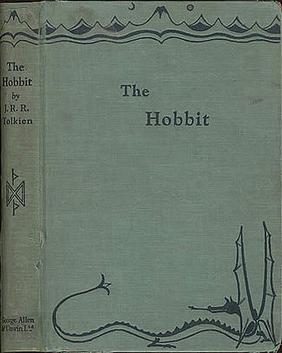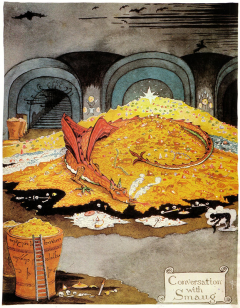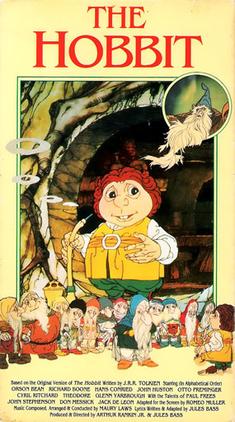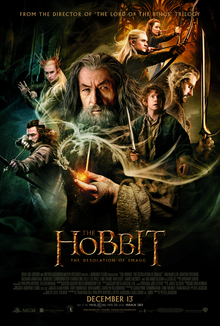
The Hobbit, or There and Back Again is a children's fantasy novel by the English author J. R. R. Tolkien. It was published in 1937 to wide critical acclaim, being nominated for the Carnegie Medal and awarded a prize from the New York Herald Tribune for best juvenile fiction. The book is recognized as a classic in children's literature and is one of the best-selling books of all time, with over 100 million copies sold.

Smaug is a dragon and the main antagonist in J. R. R. Tolkien's 1937 novel The Hobbit, his treasure and the mountain he lives in being the goal of the quest. Powerful and fearsome, he invaded the Dwarf kingdom of Erebor 171 years prior to the events described in the novel. A group of thirteen dwarves mounted a quest to take the kingdom back, aided by the wizard Gandalf and the hobbit Bilbo Baggins. In The Hobbit, Thorin describes Smaug as "a most specially greedy, strong and wicked worm".
Thorin Oakenshield is a fictional character in J. R. R. Tolkien's 1937 novel The Hobbit. Thorin is the leader of the Company of Dwarves who aim to reclaim the Lonely Mountain from Smaug the dragon. He is the son of Thráin II, grandson of Thrór, and becomes King of Durin's Folk during their exile from Erebor. Thorin's background is further elaborated in Appendix A of Tolkien's 1955 novel The Return of the King, and in Unfinished Tales.

In J. R. R. Tolkien's legendarium, the Lonely Mountain is a mountain northeast of Mirkwood. It is the location of the Dwarves' Kingdom under the Mountain and the town of Dale lies in a vale on its southern slopes. In The Lord of the Rings, the mountain is called by the Sindarin name Erebor. The Lonely Mountain is the destination of the protagonists, including the titular Hobbit Bilbo Baggins in The Hobbit, and is the scene of the novel's climax.

Bilbo Baggins is the title character and protagonist of J. R. R. Tolkien's 1937 novel The Hobbit, a supporting character in The Lord of the Rings, and the fictional narrator of many of Tolkien's Middle-earth writings. The Hobbit is selected by the wizard Gandalf to help Thorin and his party of Dwarves to reclaim their ancestral home and treasure, which has been seized by the dragon Smaug. Bilbo sets out in The Hobbit timid and comfort-loving, and through his adventures grows to become a useful and resourceful member of the quest.
In the fantasy of J. R. R. Tolkien, the Dwarves are a race inhabiting Middle-earth, the central continent of Arda in an imagined mythological past. They are based on the dwarfs of Germanic myths who were small humanoids that lived in mountains, practising mining, metallurgy, blacksmithing and jewellery. Tolkien described them as tough, warlike, and lovers of stone and craftsmanship.

Esgaroth, or Lake-town, is a fictional community of Men upon the Long Lake that appears in the 1937 novel The Hobbit by J. R. R. Tolkien. Constructed entirely of wood and standing upon wooden pillars sunk into the lake-bed, the town is south of the Lonely Mountain and east of Mirkwood. The town's prosperity is apparently built upon trade between the Men who inhabit it, and the Elves and the Dwarves of northern Middle-earth. The chief mode of transport of the people of Esgaroth is stated to be their boats.

The Hobbit is a 1977 American animated musical television special created by Rankin/Bass and animated by Topcraft. The film is an adaptation of the 1937 book of the same name by J. R. R. Tolkien; it was first broadcast on NBC in the United States on Sunday, November 27, 1977. The teleplay won a Peabody Award; the film received a Christopher Award.
Balin is a fictional character in J. R. R. Tolkien's world of Middle-earth. A Dwarf, he is an important supporting character in The Hobbit, and is mentioned in The Fellowship of the Ring. As the Fellowship travel through the underground realm of Moria, they find Balin's tomb and the Dwarves' book of records, which tells how Balin founded a colony there, becoming Lord of Moria, and that the colony was overrun by orcs.
The following outline is provided as an overview of and topical guide to the real-world history and notable fictional elements of J. R. R. Tolkien's fantasy universe. It covers materials created by Tolkien; the works on his unpublished manuscripts, by his son Christopher Tolkien; and films, games and other media created by other people.
The Hobbit is a 1968 BBC Radio adaptation of J. R. R. Tolkien's 1937 children's fantasy novel of the same name.

The History of The Hobbit is a two-volume study of J. R. R. Tolkien's 1937 children's fantasy novel The Hobbit. It was first published by HarperCollins in 2007. It contains Tolkien's unpublished drafts of the novel, with commentary by John D. Rateliff. It details Tolkien's various revisions to The Hobbit, including abandoned revisions for the unpublished third edition of the work, intended for 1960, as well as previously unpublished original maps and illustrations drawn by Tolkien.

The Hobbit is a 2003 action-adventure game developed by Inevitable Entertainment for the GameCube, PlayStation 2 and Xbox, by The Fizz Factor for Microsoft Windows, and by Saffire for the Game Boy Advance. It was published by Vivendi Universal Games subsidiary Sierra Entertainment.

Tauriel is a fictional character from Peter Jackson's feature film adaptation of J. R. R. Tolkien's The Hobbit. The character does not appear in the original novel, but was created by Peter Jackson, Philippa Boyens, and Fran Walsh as an expansion of material adapted from the novel. She appears in the second and third films in that trilogy, The Hobbit: The Desolation of Smaug and The Hobbit: The Battle of the Five Armies.

The Hobbit: The Desolation of Smaug is a 2013 epic high fantasy adventure film directed by Peter Jackson from a screenplay by Fran Walsh, Philippa Boyens, Jackson, and Guillermo del Toro, based on the 1937 novel The Hobbit by J. R. R. Tolkien. The sequel to 2012's The Hobbit: An Unexpected Journey, it is the second instalment in The Hobbit trilogy, acting as a prequel to Jackson's The Lord of the Rings trilogy.

The Hobbit, full title The Fabulous Journey of Mr. Bilbo Baggins, The Hobbit, Across the Wild Land, Through the Dark Forest, Beyond the Misty Mountains. There and Back Again is a 1985 Soviet television play for children. It is a adaptation of J. R. R. Tolkien's 1937 children's fantasy novel The Hobbit by Vladimir Latyshev.

The Hobbit: The Battle of the Five Armies is a 2014 epic high fantasy adventure film directed by Peter Jackson from a screenplay by Fran Walsh, Philippa Boyens, Jackson, and Guillermo del Toro, based on the 1937 novel The Hobbit by J. R. R. Tolkien. The sequel to 2013's The Hobbit: The Desolation of Smaug, it is the final instalment in The Hobbit trilogy, acting as a prequel to Jackson's The Lord of the Rings trilogy.












